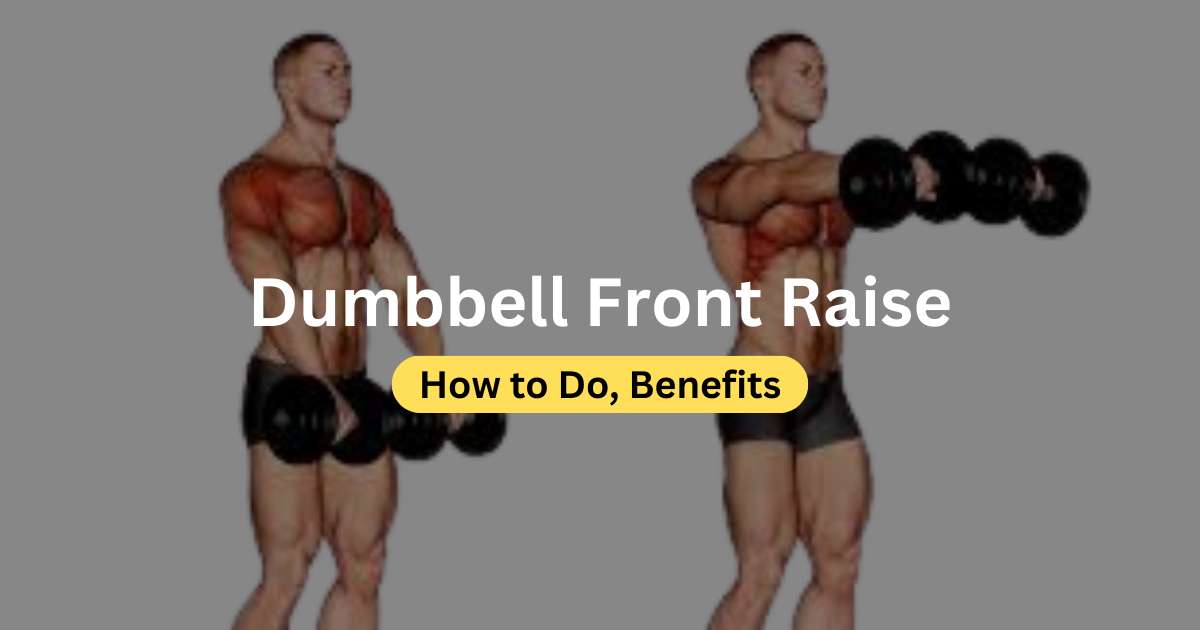Never fear, because this complete guide to the dumbbell front raise exercise is here! This article will go over the fine details of a dumbbell front raise from how to correctly do them, what doing them can help with, and exactly where it fits in for your chest.
If you are a complete beginner or experienced fitness advocate, knowing how to perform the dumbbell front raise properly will help get those optimal results and finally make all of your goals gainzzz!


What is Dumbbell Front Raise?
Dumbbell front raise is a shoulder exercise that works the anterior deltoid muscle – The main part of your shoulder.
These muscles are responsible for drawing your arm out in front of your body, an action you can easily do when preparing for a shoulder workout.
Dumbbell Front Raise : This exercise trains your anterior deltoids, increasing the strength of these muscles and improving shoulder stability as well upper body performance.
How to do Dumbbell Front Raise?
How to do a Dumbbell Front Raise
1. Place your legs in the same position you would do for a traditional deadlift, and hold two dumbbells with both hands.
2. Make sure to avoid hyper-extension in your arms and keep a neutral back.
3. Start to lift the dumbbells in front of you with arms extended from your body maintaining parallel with the floor.
4. Hold for a short pause at the top of that motion and then bring it back down in control.
5. Do it for repetitions as required
Dumbbell Front Raise Muscles Worked
A dumbbell front raise. is a powerful exercise and the reason that it works so well is because, when you lift weights in this manner, there are many areas of your body involved in lifting them up over time. The muscles of the anterior shoulder or front deltoids are primarily used. They are the muscles that lift your arms in front of your body. A great way to work those front deltoid muscles is by doing the dumbbell front raise, which will naturally strengthen and create mass in this area increasing stability of your shoulders as a whole while also improving total upper body strength.
The front dumbbell raise works the anterior deltoids or front of your shoulders with some secondary muscle action from other muscles as well. The upper chest muscles are also a part of these muscle groups. Although the shoulders are emphasised, the upper chest muscles act synergistically to stabilise and assist in this exercise. One of its added benefits is that it can help enhance chest development and lead to a more aesthetically pleasing upper body physique.
Note: Muscle activation can vary depending on grip width, range of motion and form. Although the upper chest works in an isometric stabilisation role on this exercise, during all phases of front raise it’s the same shoulder joint muscles (front deltoids primarily) that are worked. You can effectively work out these muscles with this exercise, which will also strengthen and tone your chest, shoulders for better shoulder development.
Benefits of Dumbbell Front Raise
Benefits Of A Dumbbell Front Raise For The Shoulders And Chest Here, dive into this in a little more depth.
1. Front Deltoids
- Strong front deltoids: Shoulder stability impairs as a result of poorly-trained shoulders and makes the shoulder joint at risk for further injuries, leaving them more susceptible to impingement or overall lack in working efficiently.
- Increased Upper Body Strength: The dumbbell front raise targets the front deltoids and can help build stronger upper body strength, helping with daily activities or other exercises.
2. Engaging the Chest Muscles
- Better Chest Development: Dumbbell front raise is a shoulder workout but we also see the engagement of upper chest muscles as secondary movers. This results in better development of the chest and a more balanced upper body.
3. Postural Benefits
- Better Posture: The anterior deltoid muscles when targeted and trained to perfection help you in promoting good poise so that the person can sit or stand upright instead slouching all the time.
4. Prevention of Injury and Joint Health
- Increased Shoulder Mobility : Using dumbbells for front raises involve the anterior deltoid that can be used to develop strength and improved mobility so you can actually achieve more range of motion in your shoulder, helping with stiffness.
- Prevents Injuries: Dumbbell front raise builds the shoulder muscles that can help in preventing injuries especially those related with repetitive actions of Shoulder.
Best Dumbbell Front Raise for Chest
In order to optimise the dumbbell front raise for chest development, keep this in mind:
1. Adjusting Grip Width
- Grip Wider: Holding the dumbbells with a wider grip for working more outer chest.
- Close Grip: Gripping the dumbbell with a close grip is going to target more of your inner chest.
2. Modifying Range of Motion
- Full Range: Lift the weights to shoulder height during the dumbbell front raise, and use a full range of motion.
- Partial Range: Limit the range of movement by bringing just to a comfortable elevation in adhering and raise tension on upper body muscles.
3. Incorporating Angles
- Incline Dumbbell Front Raise: Generally, this is a way of doing the dumbbell front raise using an incline bench and it may help to hit higher chest muscles.
- Decline Dumbbell Front Raise: The inclines raise of a dumb at an angle to work on lower chest pieces.
4. Mind-Muscle Connection
- Maintain the focus on contracting and squeezing your pecs through every inch of the motion.
Pro Tips
Maximise Your Performance & Results With The Dumbbell Front Raise – Pro Tips
1. Gradually Add Weight: Begin with lighter weights that allow you to effectively execute the form and there just for before advancing up in weight.
2. Control the Movement: Do not use momentum or swing your body to pick up the weights. Be sure to perform a slow, controlled motion during this exercise.
3. Also, Contract Your Core: To stabilise you through the raised dumbbells and reduce unnecessary strain from using improper form.
4. Breathe Correct: Exhale on the way down and inhale during the contraction to remain in proper breathing patterns which will also contribute to maintaining good stability…
5. Integrate with Additional Exercises: Add the dumbbell front raise to a complete chest workout, combining it with push-ups, bench presses and flyes.
Conclusion
Dumbbell Front RaiseThe front raise is yet another versatile exercise that targets the anterior deltoids and a bit of chest involvement as well.
Integrate this move into your workout routine for some shoulder strength, better chest development and posture with a well balanced upper body.
Safety first, listen to your body and always consult with a fitness professional when necessary. This guide has given you the know-how to do dumbbell front raises properly meaning that now nothing is stopping from unlocking their magic in your fitness journey.
Pick up those dumbbells, keep your form on point and reap the benefits of doing one kickass exercise!
Read More
- 20 Best Running Milestones for Beginner to Advance Runners
- 10 Best Beneficial Lat Dumbbell Exercises: Complete Guide
- Dumbbell Skull Crusher: How to do, Variations, Form and Benefits
FAQ’s
Get answers to commonly asked questions about dumbbell front raises, including their effectiveness, targeted muscles, benefits, and proper form.
Ques1- Are dumbbell front raises effective?
Yes, dumbbell front raises are effective for targeting the front deltoid muscles and improving shoulder strength and stability.
Ques2- What muscles do the front dumbbell raise work?
The front dumbbell raise primarily targets the front deltoid muscles of the shoulders, but it also engages the upper chest muscles as secondary movers.
Ques3- What is the benefit of dumbbell raises?
Dumbbell raises offer several benefits, including strengthening the shoulders, enhancing chest development, improving posture, and increasing upper body strength.
Ques4- What is the best form for a front raise?
The best form for a front raise involves standing with feet shoulder-width apart, keeping a slight bend in the elbows, and lifting the dumbbells in front of the body to shoulder height while maintaining control and avoiding swinging or using momentum.





